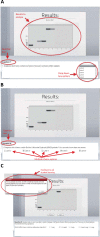Evaluation of an adaptive virtual laboratory environment using Western Blotting for diagnosis of disease
- PMID: 25331335
- PMCID: PMC4287185
- DOI: 10.1186/1472-6920-14-222
Evaluation of an adaptive virtual laboratory environment using Western Blotting for diagnosis of disease
Abstract
Background: Providing large numbers of undergraduate students in scientific disciplines with engaging, authentic laboratory experiences is important, but challenging. Virtual laboratories (vLABs) are a potential means to enable interactive learning experiences. A vLAB focusing on Western Blotting was developed and implemented in a 3rd year undergraduate Pathology course for science students to facilitate learning of technical molecular laboratory skills that are linked to development of diagnostic skills. Such skills are important for undergraduates in building a conceptual understanding of translation of laboratory techniques to changes in human biology due to disease.
Methods: The Western Blotting vLAB was developed and deployed using the Adaptive eLearning Platform (AeLP) developed by Smart Sparrow (https://www.smartsparrow.com/). The vLAB was evaluated to assess students' perceptions of their laboratory skills relevant to the diagnosis of Muscular Dystrophy. A blended learning rotation model was applied in which wet laboratory and vLAB environments for Western Blotting were both delivered to three consecutive cohorts of 3rd year science undergraduates undertaking a Muscle Diseases practical class. Evaluation questionnaires were administered at the completion of the practical classes.
Results: Students indicated in online questionnaires that the Western Blotting vLAB was at least equivalent to the real lab in their perceived development of concepts, laboratory skills and diagnosis of disease.
Conclusions: vLABs have great potential for improving students' development of diagnostic skills. Further studies are required to determine the impact of vLABs on student learning.
Figures





Similar articles
-
Empirical evaluation of a virtual laboratory approach to teach lactate dehydrogenase enzyme kinetics.Ann Med Surg (Lond). 2016 Apr 28;8:6-13. doi: 10.1016/j.amsu.2016.04.019. eCollection 2016 Jun. Ann Med Surg (Lond). 2016. PMID: 27257479 Free PMC article.
-
Virtual Simulations as Preparation for Lab Exercises: Assessing Learning of Key Laboratory Skills in Microbiology and Improvement of Essential Non-Cognitive Skills.PLoS One. 2016 Jun 2;11(6):e0155895. doi: 10.1371/journal.pone.0155895. eCollection 2016. PLoS One. 2016. PMID: 27253395 Free PMC article.
-
Video feedback and e-Learning enhances laboratory skills and engagement in medical laboratory science students.BMC Med Educ. 2019 Aug 14;19(1):310. doi: 10.1186/s12909-019-1745-1. BMC Med Educ. 2019. PMID: 31412864 Free PMC article.
-
Is there a place for e-learning in clinical skills? A survey of undergraduate medical students' experiences and attitudes.Med Teach. 2009 Jan;31(1):e6-12. doi: 10.1080/01421590802334317. Med Teach. 2009. PMID: 19253150
-
Benefits and challenges in the implementation of virtual laboratory simulations (vLABs) for medical biochemistry in Indonesia.Biochem Mol Biol Educ. 2022 Mar;50(2):261-272. doi: 10.1002/bmb.21613. Epub 2022 Feb 23. Biochem Mol Biol Educ. 2022. PMID: 35194941
Cited by
-
Student perceptions of online and in-person microbiology laboratory experiences in undergraduate medical education.Med Educ Online. 2020 Dec;25(1):1710324. doi: 10.1080/10872981.2019.1710324. Med Educ Online. 2020. PMID: 31928152 Free PMC article.
-
Cytopathology whole slide images and adaptive tutorials for senior medical students: a randomized crossover trial.Diagn Pathol. 2016 Jan 8;11:1. doi: 10.1186/s13000-016-0452-z. Diagn Pathol. 2016. PMID: 26746436 Free PMC article. Clinical Trial.
-
Personalized adaptive learning in higher education: A scoping review of key characteristics and impact on academic performance and engagement.Heliyon. 2024 Oct 22;10(21):e39630. doi: 10.1016/j.heliyon.2024.e39630. eCollection 2024 Nov 15. Heliyon. 2024. PMID: 39524879 Free PMC article.
-
Perception of online and face to face microbiology laboratory sessions among medical students and faculty at Arabian Gulf University: a mixed method study.BMC Med Educ. 2022 May 30;22(1):411. doi: 10.1186/s12909-022-03346-2. BMC Med Educ. 2022. PMID: 35637505 Free PMC article. Review.
-
Cytopathology whole slide images and virtual microscopy adaptive tutorials: A software pilot.J Pathol Inform. 2015 Sep 28;6:54. doi: 10.4103/2153-3539.166016. eCollection 2015. J Pathol Inform. 2015. PMID: 26605119 Free PMC article.
References
-
- Bernhard J. Insightful learning in the laboratory: Some experiences from ten years of designing and using conceptual labs. Eur J Eng Educ. 2010;35(3):271–287. doi: 10.1080/03043791003739759. - DOI
-
- Dobrzañski L, Honysz R. Materials science virtual laboratory as an example of the computer aid in materials engineering. Journal of Achievements in Materials and Manufacturing Engineering. 2007;24(2):219–222.
-
- Carnevale D. The Virtual Lab Experiment. The Chronicle of Higher Education Section: Information Technology. 2003;49(21):A30.
-
- Chandler P, Sweller J. Cognitive Load Theory and the Format of Instruction. Cogn Instr. 1991;8(4):293–332. doi: 10.1207/s1532690xci0804_2. - DOI
Pre-publication history
-
- The pre-publication history for this paper can be accessed here:http://www.biomedcentral.com/1472-6920/14/222/prepub
Publication types
MeSH terms
LinkOut - more resources
Full Text Sources
Other Literature Sources
Miscellaneous

